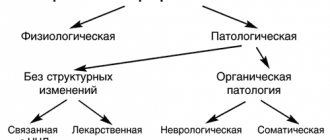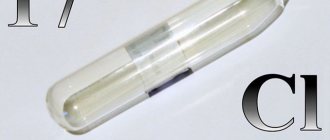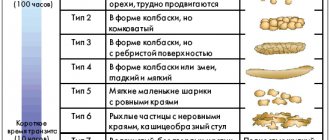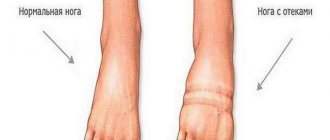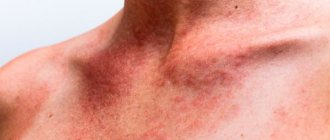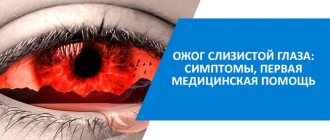What should you do and what measures should you immediately take at home if you are bitten by a wasp? Follow the rules of first aid, familiarize yourself with the common mistakes that most victims make and do not repeat them. In the article, we will tell you how to prevent anaphylactic shock from occurring, how to relieve allergy symptoms, and in which case you should immediately consult a doctor after a wasp sting. For young children, wasp bites are even more dangerous than for an adult, so we will give recommendations for relieving swelling and pain relief of the damaged area of the baby’s skin and tell you whether it is necessary to go to the clinic.
Bite symptoms
A wasp or bee sting is not a scratch that can go unnoticed. When bitten, lightning pain always appears in the area where the sting penetrates the epithelium. At the same time, the person feels as if he received a burn, intense and long-lasting. The signs of a puncture are so obvious that it is impossible to confuse them with another puncture.
Symptoms that appear:
- redness of the stung area - a red spot without clear contours is observed. The spot also has an irregular shape, with clear outlines, like a red patch. The amount of redness and color saturation will depend on the sensitivity of the victim to insect venom;
- acute pain – its appearance is sudden, with varying degrees of intensity, with the possible manifestation of a gag reflex. Severe pain discomfort can occur for either a couple of minutes or several hours;
- itching sensation – observe how the painful sensation decreases. Sometimes it manifests itself brightly, with the ability to irritate. When the bitten area itches, there is a risk of infection under the skin;
- swelling - if there is no hypersensitivity, then its localization is observed only in the circle of the puncture with the sting. If a wasp stings the facial area, head, or neck, the swelling is more pronounced and persists throughout the day, even if there is no allergy.
wasp sting
In addition, the victim’s body temperature increases, fever, and rash appear. When an insect is bitten on the tongue, severe swelling occurs in both the affected area and the mucous membranes of the oral cavity and pharynx, and the person experiences an attack of suffocation.
Due to the natural course, the symptoms disappear after a few days, while allergy sufferers suffer for another 14 days.
In addition to the standard manifestations of an insect bite, a victim with an allergy may experience:
- attacks of tachycardia;
- severe shortness of breath;
- chills;
- losing your mind for a while.
If a person with allergies is bitten by a wasp, what should you do? These conditions are unsafe for human life and require immediate assistance.
How to get rid of swelling after a wasp sting
As is known, the content of a sufficiently large number of different substances in wasp venom can completely block a person’s condition and well-being. In order for insect venom to appear as little as possible, you need to remember the following:
- Take all possible measures to block the poison.
- Try to avoid an allergic reaction.
- Try to relieve swelling at the wound site as quickly as possible.
- Remember, if a wasp sting itches, don’t do anything, this is a completely normal reaction of the body.
As soon as the victim begins to carefully approach the problem of a stinging insect bite, his condition will noticeably improve and in the future he will be able to avoid many of the unpleasant consequences of this incident.
To begin to act correctly, you first need to understand whether an allergic reaction is occurring. If this occurs, then the swelling at the wound site may be much larger in size, in contrast to a normal reaction without an allergy.
It is also worth knowing that in the absence of allergies and the body’s normal reaction to a stinging insect bite, a person may not do anything at all and the swelling should go away on its own by the fourth day maximum. But, as a rule, a wasp sting causes too many uncomfortable sensations that you want to get rid of as quickly as possible.
Remember that the sore spot may continue to itch for a long time, just try to be less distracted at this point. If a child becomes a victim of a wasp, constantly remind them that they should scratch the sore spot as little as possible.
In the absence of allergic reactions, to relieve swelling, a person can lubricate the wound with the following ointments, which will have a quick and effective effect in relieving swelling and other unpleasant signs: hydrocortisone ointment, Fenistil, Prednisolone, Hydrocortisone, Advantal . If any are present, immediately apply them to the affected area; this must be done in the very first hours after providing assistance. After all, having done this, the ointment will relieve swelling, itching and swelling on the wound. Do not forget to smear the sore spot and the subsequent time after the effects have eased.
In addition to ointments, a person suffering from allergies will also need an antiallergic drug that will prevent the development of allergic reactions: Suprastin, Tavegil, Diphenhydramine.
First aid
If bitten by a wasp, what to do at home? If the victim does not have an allergic reaction to the sting, first aid for a wasp sting is provided at home. For this, the person is seated, placed in a comfortable position, providing him with fresh air, or taken outside.
applying cold
Next, a series of measures are carried out.
- You need to calm down, because a wasp sting is very painful and leads to stress.
- Brush away the insect without waving your arms or making sudden movements. Do not crush the insect, as it will attack again along with its relatives.
- The sting does not remain, so there is no need to remove anything from the wound. The only thing when you need to remove it from your hand or other area is if the insect was crushed after being stung, do this with your finger or using tweezers.
- Wash the wound thoroughly with soap foam and lemon juice. Thanks to lemon juice, you can not only eliminate contamination, but also eliminate any remaining poison.
- Next, the puncture is disinfected using medical alcohol, brilliant green, manganese solution, and peroxide.
- Cold is applied for half an hour, since inflammation instantly occurs in the area where the poison passes, accompanied by an increased flow of blood to the wound. This leads to a rapid spread of poison into nearby tissues and the entire body. Cold from ice or a wet towel will help the blood vessels to quickly narrow, slow down the blood flow, and relieve pain.
- You need to lie down, drink a lot of fluids - green tea, Regidron solution, mineral water.
- Even if there is no allergy, medications are required. These are antihistamines - Zodak, Tavegil, Claritin, which are taken after calculating the dosage and after reading the list of restrictions.
Zodak
If, after puncturing the insect, there are no signs other than minor swelling, burning and pain, then treatment is carried out at home, without going to the doctor.
How to treat a bite
Even if a person does not suffer from allergies, he still needs to know what to do at home if he is bitten by a wasp, especially a child. The stings are very painful, the pain is stronger than from a bee. Relieving pain is the main task. In hot and sunny summers, you also need to know the rules of first aid for sunstroke and heatstroke. Read more in this material.
First aid
The affected area needs to be washed and a cold compress applied.
Let's find out what to do if a wasp has bitten an arm, leg (the most common cases) or another part of the body:
- Rinse the affected area with cold water to remove dirt and any remaining poison. You can also apply a cold compress or a piece of ice.
- Disinfect the wound - alcohol, iodine, hydrogen peroxide, etc. will do.
- If swelling and itching intensify, then lubricate the affected area with an antihistamine such as Fenistil gel. An alternative is to apply a piece of cloth soaked in vinegar.
- Take Suprastin, Claritin, Loratadine tablets to avoid allergy complications.
- In case of anaphylactic shock or angioedema, seek medical help immediately. While waiting for the medical team, the victim needs to take a supine position, placing his legs at a level above his head.
- In case of general intoxication of the body, it is recommended to drink a lot of liquid - it can be plain water or very sweet tea.
There is no need to try to pick at the wound to find the sting, because only bees leave them.
What to do if a wasp bites a child? First, give an antihistamine according to the age category, then disinfect the wound and use folk remedies (lemon juice, onion, vinegar) to neutralize the poison.
How to treat the affected area
- In case of severe itching, you can apply grated raw potatoes to the wound.
- Fresh celery juice mixed with a little wine vinegar will help relieve itching.
- You can use compresses made from pharmaceutical alcohol or pure distillate.
To relieve swelling and itching, apply a cut onion to the affected area for 15 minutes. - Apply the cut onion and leave for 15 minutes. This vegetable will secrete juice, which, penetrating into the irritated area, will relieve swelling and itching.
- Calendula essential oil has a calming effect.
- Lemon juice helps eliminate swelling.
- The wound can be treated with a banana. To do this, you need to steam it, peel it and cool it. Then mash with a fork until it becomes a thick jelly and rub the bite area with it.
- Apply a handkerchief soaked in vinegar for half an hour.
Allergy to wasp venom
Insect venom releases histamine and other components that trigger the onset of an allergic reaction. Therefore, you need to know what to do if a wasp bites you and a person’s arm or leg swells.
Allergies are divided into several degrees of severity:
- Mild degree. Redness and swelling at the site of the bite (a normal reaction of the body).
- Average degree. Redness and swelling, difficulty breathing, abdominal cramps, diarrhea and vomiting.
- Severe degree. Anaphylactic shock develops. In this case, immediate medical attention is required.
The increased risk of developing a severe anaphylactic allergy reaction most often occurs in people with chronic heart problems and asthmatics . If a local allergic reaction occurs (swelling around the bite site), you must do the following:
- Take an antihistamine as soon as possible. It blocks the action of histamine, a substance that is released by some cells in the body during an allergic reaction.
- Apply a cold compress to reduce pain and swelling. You can use a piece of cloth or an ice bag.
- What to do if a wasp has bitten your finger and a person experiences excruciating discomfort throughout the entire arm: analgesics such as paracetamol or ibuprofen will help, they relieve pain .
- If a severe allergic reaction develops, the allergic person must be given adrenaline.
In the next video, a candidate of medical sciences will tell you how to provide assistance with a wasp sting.
Allergy tests
To diagnose an allergy to insect venom, a skin test or blood tests for specific IgE antibodies are performed. The only way to alleviate the symptoms of an allergic reaction is to systematically administer small doses of insect venom. This procedure is performed in a hospital or outpatient setting. Your doctor will give you an injection regularly to help keep your immune system functioning properly. This treatment lasts 5 years and guarantees a 90% result.
If the swelling becomes more and more, this is a reason to consult a doctor.
If an anaphylactic reaction occurs, allergy tests with a type of insect allergen should be performed 2-3 weeks after the bite.
Recommends performing a skin prick test . In this case, variously diluted amounts of insect venom are applied to the skin, and then the skin itself is injected with a special lancet.
Depending on the body's reaction, the degree of the allergic reaction is determined. If the first test is negative, it should be repeated after 4-6 weeks. Such manipulations should only be performed by an experienced allergist, who can skillfully prevent the development of allergies during the test.
What not to do
Improper implementation of measures after a wasp sting causes more severe reactions, increasing the negative symptoms. It happens that the victim ends up in hospital treatment due to incorrect manipulations, like being bitten by an insect.
What not to do when bitten by a wasp:
- Do not look for a sting in the wound; it is absent.
- It is forbidden to squeeze out the poison, as this leads to its distribution throughout the bloodstream.
- Picking or scratching the bite will lead to suppuration.
- Dip the bitten area in dirty water, do not cover it with soil, as infection may occur.
- Drink more, since swelling does not develop from the amount of water you drink; on the contrary, liquid leads to a decrease in the main signs of poisoning.
- Alcoholic beverages and smoking are prohibited.
- Cauterize the bitten area.
bite manifestation
You should also not leave the victim in an anaphylactic state. Wait until the doctors arrive.
Unusual ways
Earwax may reduce inflammation after a wasp sting
Traditional medicine suggests using methods that at first glance seem unusual. For example, there are recommendations to lubricate the bite site with earwax.
This will help relieve the sharp pain and somewhat slow down the allergic reaction. At the same time, it is important to ensure that it does not get into an open wound, since microbes accumulate in the ear secretions, which can cause infection and the formation of a purulent process.
Ripe tomatoes will also be useful. To do this, you should mash the tomatoes until they become mushy, then apply an application to the bite area and cover the top with a paper napkin so that the juice does not spread over the body. If there are no ripe tomatoes, do not hesitate to use green ones. To do this, just cut the berry in half, apply it to the wound and secure it with a bandage for several hours.
The note. A cotton compress with a solution of salt or glucose will help relieve swelling and inflammation, which will reduce the absorption of poison. It should be applied in the first hours after the bite.
Traditional healers suggest using raw potato tubers to treat insect bites. To do this, they should be grated with fine holes, placed in gauze, and then applied for 30-40 minutes.
If the swelling lasts more than three days and does not subside, then it can be lubricated with olive, linseed or sunflower oil. The itching will calm down after a while, and the swelling will begin to decrease after 24 hours.
You can apply nettle to the sting site, but it is advisable to rub it thoroughly to break the stinging hairs. There are recommendations for using nettle burns.
To do this, it is recommended to whip the bite site several times with a burning plant, after which the swelling will supposedly go away. However, such actions are rather questionable, since an allergic reaction from a wasp sting will be accompanied by a reaction to nettle toxins that is similar in nature.
Bite danger to humans
Every year, wasps become more aggressive and pose a danger to people, since these insects collect from fields that are treated with various pesticides and herbicides. Victims are increasingly visiting doctors after being stung by an insect, and do not know what to do.
When a person is absolutely healthy, then a lethal dose of wasp venom is 500 stings. But for allergies, 1 bite is enough. The pest's venom is a colorless liquid with a bitter aftertaste. It contains biological elements; a small amount of them will provoke a number of pathophysiological reactions.
Dangerous symptoms that occur after a puncture by an individual:
- the face, neck, skin in the chest area turns red;
- urticaria slowly appears;
- temperature increases;
- the patient is chilling;
- hands are shaking;
- pressure is disturbed;
- weakness appears;
- soft tissues and mucous membranes swell;
- hoarseness appears;
- breathing becomes difficult.
chills
The most dangerous wasp bite is considered to be if it occurs in the area of the oral mucosa. In this situation, the insect does not spare the poison, since it gets scared due to the cramped space. So, there is swelling of the tongue and larynx. If the tongue swells, it is not fatal, but swelling of the larynx leads to suffocation. You should not hesitate if an insect bite occurs on your neck, an acute reaction occurs and your breathing will be blocked. Therefore, immediate medical assistance is required.
Also unsafe is a bite to the skin around the eyes. Swelling of half the face is observed, and discharge from the eyes is possible. This causes inflammation.
Why is a wasp sting dangerous for humans?
In recent summers, wasps have become more aggressive - this is attributed to the fact that insects collect nectar from plants flavored with chemicals. Such nutrition makes the wasp venom stronger - even one attack by a “minke whale” can pose a danger to people, especially small and elderly people. The risk group also includes pregnant women - in a new state, the body may react unexpectedly to a wasp attack.
The bite itself is not so serious - the poison is dangerous, saturated with enzymes and biological substances that cause an allergic reaction in humans. The most harmless are bites on a limb, leg, arm, fingers. The greatest danger is when stung in the neck, ear, or face.
The most dangerous thing is bites in the mucous membrane - when the wasp gets into the nose or mouth. Frightened by a confined space, the insect secretes a large volume of poison. This provokes severe swelling, which can narrow or even completely block the airways. The victim should be quickly taken to the hospital.
What to do if a child is bitten
If a child is stung by a wasp, what should you do? The manipulations for stinging are identical to those for piercing an adult. But it is better not to carry out treatment at home, but to immediately consult a doctor.
First, when children are bitten by a wasp, they are given an antihistamine according to their age, then the wound is disinfected. To neutralize the poison, they use folk remedies - lemon juice, onion, vinegar. Apply antiallergic ointment to the bite site, use Ketopin, Fenistil, Panthenol.
If the bites of individuals occurred on the face, neck, lips, tongue, then you need to immediately go to the doctor, and especially if there were 2 or more bites.
Panthenol
Characteristic symptoms
After a sting, certain signs are noticeable on the body:
- swelling;
- red-pink tint of the epidermis;
- skin itching;
- throbbing pain;
- when the eyelid is stung, the facial tissue becomes very swollen, the eyes are practically invisible due to noticeable swelling, and hemorrhage often occurs in the conjunctival area;
- in children and women, symptoms from an insect bite are more acute;
- a sting on the tongue causes severe swelling not only of the affected area, but also of the mucous membranes of the mouth and larynx, and the person suffocates.
With increased sensitization of the body, anaphylactic reactions develop:
- pronounced swelling;
- redness of the affected area;
- pale skin;
- nausea;
- severe itching;
- the victim wheezes, an attack of suffocation is observed;
- hemorrhage in the eye area;
- loss of consciousness;
- soreness in the chest and abdominal area;
- a sharp decrease or increase in pressure;
- heart rhythm failure.
Find out the technical characteristics of the insect and rodent repellent pest repelling aid, as well as the rules for using the device.
Read about how to make effective poison for mice at home and how to use it on this page.
If you have an allergy
The individual’s venom releases histamine and other components that lead to the onset of allergies. Therefore, have an idea of what to do after a wasp sting.
A high risk of developing a serious anaphylactic manifestation during an allergic manifestation often occurs in people with chronic pathologies of the heart muscle and in asthmatics.
When a wasp has bitten and a local allergy appears - swelling around the bitten area, the following measures must be taken:
- take an antihistamine, it blocks the effects of histamine;
- apply a cold compress - this will reduce pain and swelling;
- if the bite occurs on a finger, unbearable discomfort appears in the hand, analgesics will come to the rescue - Paracetamol, Ibuprofen. They will eliminate pain;
- when a severe allergic reaction is observed, adrenaline is administered.
In addition, they use a hollow tube; it is necessary when an individual is stung, when the victim wheezes or whistles. In the warm season, people who are prone to allergies carry with them medications prescribed by a doctor and a passport of the patient with the corresponding pathology. This will allow the person who will provide first aid to the victim to quickly navigate.
Ibuprofen
How to quickly relieve swelling and redness?
The best way to relieve swelling and hyperemia is to anoint the site of the wasp bite with a product suitable for this purpose. You can, of course, try to moisten the inflamed area with table vinegar or use another folk remedy, but if you have an antihistamine ointment on hand, under no circumstances should you give it up.
Medications
When bitten by a wasp, you should take an antihistamine tablet to avoid allergic reactions. In combination with an anti-inflammatory drug, these medications will reduce pain and help lower the temperature.
Activated carbon has a good effect. It can be used internally as an adsorbent or, mixed in water, to make a soothing lotion.
As mentioned earlier, ointments with an antihistamine effect are effective locally for bites. They treat the entire inflamed area, including the border area.
Folk remedies
More often, wasps attack in the wild (at a picnic, on a hike) or in the country. If you don’t have any medications on hand, you can use folk remedies for a wasp sting:
- Gruel from plucked plantain has a universal property. It will not only disinfect and relieve pain, but also promote rapid tissue regeneration.
- Applying a paste of parsley leaves in half an hour will relieve redness, itching and relieve pain.
- Calendula (marigold) juice also has a calming effect.
- Severe itching and swelling are well relieved by a compress of celery juice mixed with wine vinegar.
- It is recommended to apply a paste of raw potatoes or onions to the wound. After 15 minutes, relief will come.
Banana is good for wasp stings. The fruit is preheated in a steam bath. Then peel and puree. When the mass has cooled, make a cake and apply it to the sore spot.
Celery juice
Medicines to relieve symptoms
Even if there is no allergy, the victim should know how to treat a wound when stung by an insect. Sting punctures bring unbearable pain syndrome, so the main task of the treating doctor’s treatment is to numb the wound. He will tell the victim how to treat a wasp sting at home.
Painkillers include ointments and gels that eliminate unpleasant symptoms from bitten areas. The application of local agents requires combination with antihistamines.
For a wasp sting, it is recommended to anoint the wound with the following medications:
- Psilo-balm;
- Fenistil gel;
- Fluorocort;
- Diprospan;
- balm Rescuer.
If you smear the bite with these medications, the swelling will decrease, blood flow in the bitten part will improve, itching will decrease, allergies will go away, and the pain will subside.
Fluorocort
Among the antihistamines used:
- Suprastinex;
- Citrine;
- Diazolin;
- Suprastin.
Antihistamines
The active components reduce histamine levels, stop the pathological process, and eliminate allergy symptoms. Apply a thin layer twice a day. Contraindication is individual intolerance to the components. Do not use longer than 7 days. To enhance the effect, take tablets, syrup, or drops for oral administration.
Effective means:
- Claritin;
- Suprastin;
- Diazolin;
- Fenistil-gel;
- Psilo-balm.
Average price 300 rub. Available without a prescription.
On a note!
In case of a severe allergic reaction, as well as if antihistamines do not help, hormonal drugs are prescribed.
Folk remedies
What to do if you are stung by a wasp if there is no medicine at home with an antiallergic effect? Folk remedies for wasp stings can relieve pain, swelling, and itching. Their use is only possible when the sting has been inserted into safe areas and the following is observed:
- on hands;
- in the fingers;
- in the area of the lower extremities;
- back;
- on the hips.
When a wasp has bitten your hand, the following methods are used:
- salt – a cloth is soaked in a saline solution and applied to the bitten area. The compress is removed after heating from the wound. Then the material is moistened again in the solution, and the compress is applied again;
- sugar - a piece is moistened with water and applied to the stung wound;
- validol - a tablet is moistened in water and glued to the wound, it will anesthetize and relieve swelling;
- parsley leaf - good at eliminating swelling, itching, and pain relief. Before applying it, you need to crush the parsley to release the juice. It is necessary to alternately lubricate the wound with the resulting juice;
- plantain – has excellent medicinal properties. The sheet is washed from dust and secured to the bitten area;
- aloe - the skin is removed from the leaf, the cut is applied to the wound, the leaf can be secured temporarily with a bandage. Aloe will eliminate pain, cool, and remove inflammation.
aloe
When a wasp has bitten the eye, immediate medical attention is required, as the function of the visual organ may be impaired. Also, a wasp sting in this area poses a threat to the life of the victim.
Features of bee and wasp stings
The attacks of these insects are often confused, and yet they have different mechanisms of action and influence on the body.
A bee's sting has serrations on its surface. During an attack, the insect plunges its sting into the upper layers of the skin and can no longer pull it back. As a result, the bee’s “tool” is separated from the body and remains in the skin, and the insect itself dies. The sting is a “tool” with which poison is injected. Its toxic effect causes the unpleasant symptoms that characterize the bite. Bee venom contains toxins that cause a reaction similar to acid. This is important because it determines the choice of method for neutralizing the poison.
The wasp’s “tool” is smooth and sharp, so it does not come off after a bite. The wasp can sting more than once if any aggression prompts it to do so. Unlike bee venom, wasp venom provokes an alkaline reaction, leading to:
- damage to the walls of skin cells;
- neuroregulation disorder;
- destruction of mast cells and release of large amounts of histamine.
In addition, the pain from a wasp sting is more pronounced than from a bee attack.
Useful: How to treat burns from hogweed
In what cases should you consult a doctor?
After a wasp sting occurs, the condition of the body is monitored. The reaction in this case is individual and occurs differently for everyone.
Seeing a doctor if you are bitten by a wasp is required in the following situations:
- a sharp deterioration in the patient’s general well-being;
- the swelling does not disappear, but becomes even larger;
- temperature rises;
- spasms appear;
- there are pronounced signs of an allergic reaction;
- there was an attack by more than 1 individual;
- the insect stung the tongue, throat, eye;
- anaphylactic shock appears;
- a child and an elderly person suffered from the bite.
A doctor's examination is necessary if a person has previously been attacked by insects, and the reaction to the bite manifested itself in an acute form.
When should you go to the hospital?
There are several cases in which you should immediately call an ambulance or go to the hospital yourself:
1. Severe inflammation began at the site of the bite;
2. The victim suffers from the following diseases:
- Asthma - first, stop the asthma attack with a special inhaler;
- For allergies of any kind - give an antihistamine;
- Heart problems - stimulate cardiac activity with valocordin, nitrospray or nitroglycerin;
3. The wasp stung a child or a pregnant woman;
4. There are several wounds on the body (for adults – more than 5, for children – more than 1);
5. The bite site is located on the face or neck;
6. The victim went into anaphylactic shock.
Medicines
The manifestation of an allergy to a bee or wasp sting has acute and rapid symptoms. In this situation, it is necessary to carry out manipulations quickly to slow down the release of toxic substances as much as possible and neutralize their effects on the body.
In case of a normal reaction to an insect bite, products based on natural ingredients, essential oils, and plant extracts are used.
- Menovazin - has the form of an ointment, solution, it contains 2 substances that relieve pain. The patient feels better immediately after applying the medicine. Treatment with the drug is carried out up to 4 times a day.
- Calendula - in ointment, solution eliminates inflammation, swelling, itching, pain.
- Asterisk - thanks to the product, it will eliminate pain, stop the pathological course, and accelerate wound healing. Apply the product to relieve redness, pain, itching, and inflammation.
- Boro-plus is an antiseptic cream and has a pleasant smell. Apply the drug up to 5 times a day.
Boro-plus
If the symptoms do not go away and the skin does not recover within 2 days, then medications are used that reduce the activity of histamines.
Antihistamines can reduce histamine levels, stop inflammation, and eliminate allergies. Apply a small layer of the medicine 2 times a day. To enhance effectiveness, use pills, syrup, drops.
Effective medications include:
- Claritin;
- Suprastin;
- Fenistil-gel;
- Psilo-balm.
It is advisable to take adsorbent drugs.
- Smecty.
- Activated carbon.
- Enterosgel.
Due to these agents, toxic substances are bound and they are quickly eliminated from the blood system, cleansing the body. When a severe allergy develops and in the absence of the desired effect from antihistamines, hormonal medications are prescribed.
Smecta
The active ingredients are hormones that belong to the group of glucocorticosteroids. They have the same effect as antihistamines, but 4 times faster.
- Reduces the effectiveness of histamine.
- Increase pressure.
- Reduce vascular permeability.
- External signs of an allergic course are excluded.
It is forbidden to treat wasp and bee stings without a doctor's prescription.
Tablets taken orally – Prednisolone, Dexamethasone. The dosage is selected based on the age of the victim. An adult takes up to 3 pills per day. The therapeutic course is determined by the complexity of the symptoms.
The following is prescribed as an ointment for bites:
- Advantan;
- Hydrocortisone;
- Elokom;
- Sinaflan.
In severe allergy situations, the victim is prescribed:
- Cordiamine – helps normalize breathing;
- Diphenhydramine – restores the natural functionality of the heart and eliminates pain;
- Adrenaline – suppresses the formation of allergies.
wasp sting allergy
The victim must be urgently hospitalized and provided with the necessary assistance in a hospital setting.
How dangerous are wasps and what varieties exist?
There are a large number of species of wasps of various colors, but they all have one feature in common: a narrow bridge connecting the abdomen to the chest - the so-called waist. This structure allows these insects to insert their stings from any angle, defeating larger insects and even small animals.
Wasps can lead both solitary and social lifestyles.
Paper wasp bites people most often
The following subspecies are single:
- sand;
- road;
- riders;
- floral;
- burrowing;
- Typhia;
- scolias;
- sparkles;
- German women
Social wasps live in families and are divided into the following types:
- Polistas are paper wasps that most often attack residents of the middle zone;
- polybiins are insects that live in the American tropics;
- Vespins are the most dangerous and aggressive wasps, which also include hornets typical of Russia.
Ground wasps do not exist in the scientific classification. This is what people call them because they often make their nests in abandoned anthills or rodent burrows.
Riders, sparkles, paper and other types of wasps - photo gallery
Spangled wasp
Road wasp
Wasp rider
German wasp
sand wasp
Paper wasp (polist)
Burrowing wasp
Scolia wasp
Typhus wasp
flower wasp
Hornet
Wasps bite people much more often than bees, and their bites are more painful. The peak of “wasp mayhem” occurs in July-August, when many sweet fruits ripen, attracting both insects and people. The wasp's sting is smooth, and after a sting, unlike a bee, it does not die, but pulls it out and attacks the victim again.
For healthy people, a single wasp sting is not so scary. You should be wary of an attack by this insect:
- small children, including those who are bottle-fed;
- frail and elderly people;
- pregnant women;
- suffering from diabetes, bronchial asthma, allergies of various origins.
At the moment of a sting, the wasp injects poison containing a large amount of histamine, a substance that causes a violent reaction in the body. This can cause serious health problems: from tissue swelling to bronchospasm, anaphylactic shock and death. Therefore, people at risk should try to avoid being in wasp habitats, and if bitten, they should immediately seek medical help.
Attention! Wasp venom is very toxic, so if a person has been bitten by more than three insects, it is necessary to urgently go to the hospital.
Wasp stings on the face cause severe swelling
Harm and consequences of a wasp sting for pregnant and lactating women, as well as children
If a wasp bites a pregnant or nursing woman, you should not worry too much: the toxins from its venom are unlikely to harm the baby. The only exceptions are expectant mothers who have been attacked by several wasps, are prone to allergies or have respiratory diseases.
The location of the lesion is of great importance. Bites on the arms, legs, fingers, palms and feet are relatively safe. It is much worse when the wasp stings in places where blood vessels come close to the skin: lips, ears, eyes, eyebrows, cheeks, temples, forehead, head. The most dangerous are bites on the tongue and neck: swelling in these places can block the supply of oxygen and without medical help a person will die from suffocation.
If a wasp stings a child, he is given the same assistance as an adult. If the bite is single, the baby is healthy and not prone to allergies, you don’t have to go to the hospital, but you need to closely monitor his condition. If a child shows signs of intoxication or breathing problems, you should immediately contact a doctor.
What to do if stung by a wasp in nature
If a wasp attacked during a rest period, and you don’t have a first aid kit with you, what is used as an aid for bee and wasp stings? The wound and surrounding skin are not washed with water. Do not immerse the bitten area in the nearest body of water. The bee sting is doused with vodka. There is no need to take alcohol internally; your health will worsen.
Plantain is also used, which has a wound-healing and tonic effect. The leaves are fixed on the wound as a lotion and bandaged.
Onions will also help in eliminating puffiness. In addition to being bactericidal, it has a sorbing property, neutralizing the toxin. The patient is advised to move less and drink more fluids.
a bite of an insect
The effect of wasp venom
Wasp venom contains substances that cause a response from the body's immune system, affecting nerve endings and disrupting the functioning of the nervous system, causing the destruction of cell walls. Among them:
- histamine;
- acetylcholine;
- phospholipases;
- hyaluronidase.
Once in the blood, the toxin spreads throughout the body. Initially, a reaction occurs at the site of the wasp sting, but gradually the swelling and redness spread. The poison, moving with the blood through various systems and organs, can cause other unpleasant symptoms.




